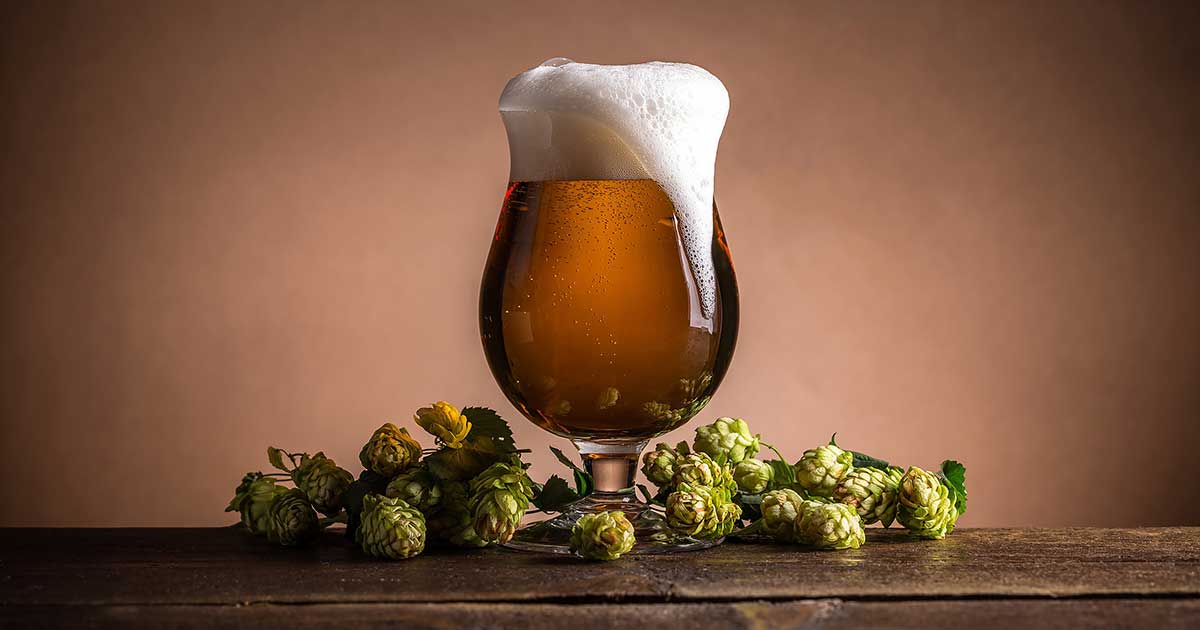We speak to seven industry professionals to learn more about the latest beer trends and the industry’s response to the COVID-19 pandemic.



Paul Choueiry
Enologist and craft brewer/
co-owner, Vagabond Beirut
What is the difference between craft beer and commercial beer?
Commercial beers are generally simple, light, easy to drink and usually served as cold as possible. Craft beers are complex, rich in aromas and flavors because they are made with high-quality ingredients, produced in small batches, served between 8°c and 12°c to enhance the flavors and can be easily paired with food, like wine.
What are the emerging beer trends?
Fruity and hazy beers are the main trend in craft brewing. The most common example is the New England IPA (NEIPA): fruity, cloudy and smooth with less bitterness compared to the usual IPAs.
What is the key component for a great beer?
Beer is made of four main ingredients: water, grains, hops and yeasts; then add to that the human factor. Everyone can brew beer, even at home; some could prove to be interesting. But to create a great beer, the ingredients should be hand-selected and the brewer must have a strong knowledge of chemistry, microbiology and biochemistry. However, the most important factor is passion.
What are some key beer facts that everyone needs to know?
• There are many different varieties of hops – like grapes, and each has its own characteristics and aroma profile.
• Very cold beer or beer served in a frozen glass is bad! It mutes almost all the flavors.
• Dark or black beers are not necessarily heavier in alcohol but are definitely richer in taste and texture.

Spyros Aimilios Kerkyras
Owner of Barsolutions Greece /42 Barstronomy Athens / Hide & Seek Athens / Branco Costa Navarino /
Hono&Lulu Spetses
What beer trends can we expect post COVID-19?
A lot has changed lately because of the pandemic and the beer industry has faced a major challenge in the last six months. Despite the general crisis in HORECA and the drinks industry, however, many innovative trends in the beer market emerged during this period. The small breweries flourished by launching new labels and flavors. Beer has now entered the process of food pairing, with great gastronomic interest. IPAs, dessert stouts and fruited sours are now the new trend, leaving pilsner and lager beers far behind.
How did consumer preferences change as a result of COVID-19?
Consumer trends have clearly changed even in the draft beer sector, with bottled beverages taking first place in terms of consumer preference.
Which are the niche beers to look out for?
The beer revolution finally arrived in 2020 with niche beers. Fruity, refreshing and for all occasions, even as an aperitif. With different profiles of malt, hops and yeast, with a taste of chocolate or coffee, ideally combined with oysters, duck or even blue cheese

Alexandros Sourmpatis
Giffard brand ambassador in Greece and
whisky portfolio of Tsaknakis Premium Brands
What beer trends can we expect post COVID-19?
After COVID-19, the beer trend is expected to shift towards stronger and full-bodied beers, rich in hops and fruity in taste.
How did consumer preferences change as a result of COVID-19?
Consumers’ preferences didn’t much change, despite the fact they were not allowed to drink in bars.
Which are the niche beers to look out for?
Beers that are bold in flavor but light in alcohol content.
How did your brand overcome the challenges of COVID-19?
Brasserie Almaza defined new ways of working since the arrival of COVID-19, prioritizing employees’ safety. The impact on business was substantial, due to lockdown
and the closure of on-premises and certain off-premises outlets. The impact on revenue and profitability is high, but we are
overcoming all these challenges.
What beer trends can we expect post COVID-19?
The trend is towards larger packs, as consumers are seeking value for their money and our larger packs have a price advantage per liter. There is also a trend supporting local brands, despite the fact that more than half the cost is based on imported ingredients and packaging material. Nevertheless, prices are rising less steeply compared to imported brands. Besides Heineken, most of the other imported brands were selling at relatively low prices. Now with the devaluation of the Lebanese pound, they are forced to increase their prices making them premium goods. Low and non-alcoholic products are on the rise as consumers are becoming more health conscious and are looking for brews that are healthier — lower in alcohol and lower in calories.
How will the shift in consumer preference towards low and nonalcoholic beers as well as craft beers affect your business?
Low and non-alcoholic beers are on the rise. Craft beer, on the other hand, is always a niche offering to aficionados. We play an important role in raising awareness by importing the best global brands: Lagunitas, Affligem and Mort Subite.
Do you have any new products in the pipeline?
We launched Almaza in a can in March 2020 for on-the-go consumption. We priced it well and it was a big hit within our portfolio, so much so that we are having difficulties importing enough cans to meet demand.
How did your brand overcome the challenges of COVID-19?
COVID-19 arrived and hit our main sales channel hard due to bar and restaurant closures under strict lockdown measures. However, we immediately reacted and were able to compensate by implementing a home-delivery beer service.
What will the post-coronavirus beer industry look like?
COVID-19 affected the global brewing industry as a whole and beer sales dropped significantly across the world. In Lebanon, overall beer consumption is likely to increase, but visibility as to which part of the beer industry (industrial or craft) will likely profit from it, is still low.
What beer trends can we expect post COVID-19?
The particularity of the beer market in Lebanon is that even after COVID-19, the economic crisis will take its toll on purchasing power. Imported beers are gradually becoming more difficult to find and consumption is shifting towards local beers. The challenge for local breweries will be to continue producing with the same quality while trying to
minimize costs across the board.
How will the shift in consumer preference towards low and nonalcoholic beers, as well as craft beers, affect your business?
At the moment, Elmir is steadily increasing its market share in both on premises and off-premises consumption as it is solidly replacing consumption of imported craft beers. I do not believe low-alcohol and non-alcoholic beers consumption will significantly vary in the years to come.
Do you have any new products in the pipeline?
We are currently working on several beers — I cannot really disclose their particularities but what is sure is that we are thinking local!
How did your brand overcome the challenges of COVID-19?
With the onset of the COVID-19 crisis, we were forced to adhere to restrictions set by the lockdown measures and shut down our manufacturing operations temporarily.
We continued to perform sales transactions by relying on our existing stock of finished goods while following up with customers and staff to ensure safety regulations were
being upheld. Although we witnessed a drop in sales during this period, we found new opportunities in e-commerce and delivery based businesses seeking to promote local
brands and products.
What will the post-COVID-19 beer industry look like?
Emerging beer trends post COVID-19 may become more evident once we reposition ourselves confidently in the global trade market. In addition, we expect to see a notable increase in local demand in light of supporting and appreciating local crafts and brands, and a heightened sense of loyalty to them.
What beer trends can we expect post COVID-19?
We expect to see a surge in demand for beer products upon the reactivation and reanimation of the F&B sector, with businesses once again welcoming customers at desired capacity while operating at favorable and sustainable levels. Once this sector has resumed normal activity, we will be ready to meet supply and demand turnover rates.
How will the shift in consumer preference towards low and nonalcoholic beers as well as craft beers affect your business?
Our products are alcohol based and crafted to offer a unique range of tastes and preferences. Consumers seeking nonalcoholic grain or soda refreshments have plenty of alternatives, which we do not consider as direct competitors. Nevertheless, there are opportunities for growth in this division, one that we are yet to evaluate.
How did your brand overcome the challenges of Covid-19?
Beirut Beer retained somewhat steady sales internationally, even with lower ontrade sales worldwide. Locally, although we reduced advertising heavily, people continued to choose Beirut Beer to drink at home and at family gatherings. Sales showed a healthy increase.
What will the post-coronavirus industry look like?
Consumers have been experiencing new brands and products since the beginning of confinement, including new cuisines and drinks. Since they already have more time available to research online, Beirut Beer’s presence on many platforms is much more important than before. There will always be the traditional beer consumers who prefer their classic beer, whatever the occasion and then the new ones that we have attracted since our inception with the right advertising. The latter are the more elusive ones that we need to reach out to on social media.
What beer trends can we expect post covid-19?
Confinement has triggered newfound curiosity in new cuisines, new workouts and new activities. This added interest in creativity is also found in the drink market, whether relating to taste, packaging or advertising. Craft beers all over the world are fun and exciting, but we must first wait for the people to be ready for them. Meanwhile we will keep brewing a classic Pilsner that has become a firm favorite among many.

















